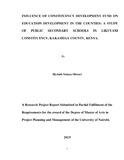| dc.description.abstract | The purpose of the study was to determine the influence of Constituency Development Fund (CDF) on Secondary school education development in Likuyani Constituency; Kakamega County in Kenya. The study used descriptive survey research design. The main findings of the study were as follows: most of the students did not receive enough bursaries to enable them pay fee charged by the school. The funds for physical facilities were not enough but projects which benefited most from CDF funds were the school land, science laboratory, administration block. Students’ enrollment, retention and completion rates kept increasing after the introduction of CDF fund although it was still below the expectation and the completion rate stood at 69%. Most respondents agreed that CDF funded bursaries have led to improved learners’ academic performance. Based on the foregoing findings, several conclusions were arrived at: First, very few poor but bright students receive bursary from CDF education fund. Secondly, CDF funds have helped to facilitate the provision of physical facilities in public secondary schools in Likuyani Constituency to a small extent, but facilities were still not enough in spite of the funding. Thirdly, the number of learners’ enrollment, retention and completion rate had significantly gone up with the introduction of CDF funds. Finally, learners’ academic performance improved with the introduction of CDF education funds but they were not enough thus learners’ academic performance in relation to CDF education funding is still low. From the findings and conclusions, the study recommends the following in order to improve the provision and management of CDF funds in education so as to realize significant education development. First, the government should allocate enough funds in time to schools to ensure that the facilities constructed are enough and are completed and adequately equipped for example science and computer laboratories as well as libraries. It should also increase funds allocated to CDF bursary so that the deserving students can fully pay their school fees thus increasing the retention and completion rates. The study established that headteachers are not fully involved in identifying the poor but bright learners thus very few deserving students benefit from the CDF fund bursary. As such, the researcher recommends that head-teachers and teachers be involved to a larger extent in identifying the deserving students. Head teachers should also involve the community around them to aid in school development programmes and projects to supplement CDF education funding. Lastly, schools should initiate income generating projects to subsidize CDF education funding. | en |

